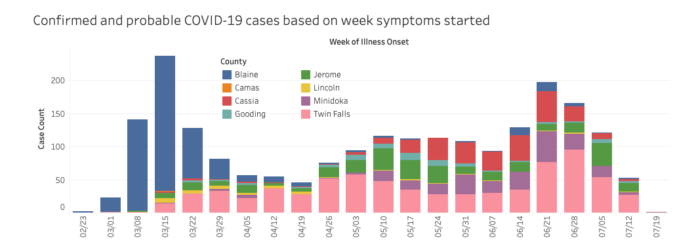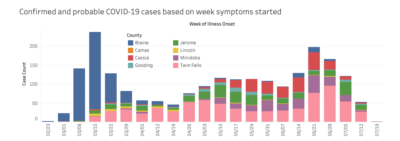
Business, healthcare find new normals in abnormal times
By Eric Valentine

With “mask up” orders Valleywide and re-opening guidelines still at their most lenient phase, healthcare providers, businesses and ordinary residents are trying to find what a new normal looks and feels like day to day. A combination of caution and optimism seems to be taking place, from a school district that plans to reopen in-person classes but three weeks late to a hospital that is back to performing elective procedures and operations but on a case-by-case basis only.
What follows is a look into business impacts from COVID and the current status of the healthcare infrastructure.
Pandemic Economics
A recent survey of more than 120 local Wood River Valley businesses, completed by Sun Valley Economic Development (SVED) on behalf of the Blaine Recovery Committee, assessed changes in the business environment brought about by the COVID pandemic.
“The loss of sales, the wearing of masks, the shift of traditional visitors to longer-term potential residents, and lack of workforce housing are just a few of the concerns shared with us,” said Harry Griffith, executive director of SVED. “Responses indicate that while businesses are doing their best to adapt to a difficult economic environment, significant uncertainty as to the future exists.”
Specifically, the survey indicates that 67 percent of respondents are currently operating normally, with the remainder either operating with reduced space (17 percent) or reduced hours (15 percent). Nearly all (95 percent) are using recommended safety and hygiene protocols such as masks for employees (73 percent), entry sanitization procedures (71 percent), and masks for customers (48 percent).
This June survey was done in partnership with Visit Sun Valley, The Chamber of Hailey and the Wood River Valley, Fly Sun Valley Alliance, Sun Valley Institute and several other community organizations. The majority of businesses responding (over 50 percent) were in the retail/restaurant/lodging sector, 25 percent in the professional services sector and the remaining 25 percent in a variety of other industries.
The impacts to June revenues (versus prior year) were varied, with 61 percent of respondents reporting reduced sales while 23 percent reported increased sales. Forward projections for the summer are likewise varied, with 50 percent expecting a 15 percent or greater decline in revenue, 12 percent expecting revenue increases and the balance no change or too early to assess. Longer term, concerns were expressed about reduced customer traffic (55 percent), lost work opportunities (41 percent), reductions in air service (40 percent) and long-term business viability (11 percent).
When asked about marketing to help attract customers, more than 60 percent indicated destination marketing for this summer was important, with 34 percent stating it was a critical need. When asked about the priority of target markets important in the near term, 75 percent supported marketing outreach to Boise/Twin Falls drive markets, 66 percent to second homeowners, 61 percent to other regional drive markets like Utah, Washington and California, 55 percent to SUN air route markets.
Healthcare Infrastructure
Let’s start with the good news. The early onslaught of COVID-19 cases that impacted Blaine County worse than any other county statewide has subsided. And St. Luke’s Wood River has restarted performing elective surgeries and other procedures.
“Our operations are as close to normal as you can be right now,” said St. Luke’s spokesperson Joy Prudek. “People are having surgeries. Babies are being born.”
But Prudek is cautioning the public that this is a new normal, not normal normal. For instance, elective surgeries and other procedures are being scheduled but when that surgery or procedure takes place is determined by a physician on a case-by-case basis.
“We have to keep some flexibility in case there is another surge of COVID here,” Prudek explained.
The hospital is also testing patients pre-operatively for COVID, and if someone tests positive, they’ll likely be denied an elective procedure until a later date.
“If you have COVID, we just don’t know how your body will do. We have to err on the side of caution,” Prudek said.
Among the challenges facing the healthcare infrastructure is the two-week delay in test results. Since July 13, labs have been overwhelmed with tests and results have been few in coming. This is a problem in two ways, Prudek points out.
First, there is the issue of whether we’re in the midst of an uptick like many places around the country and we just don’t know it yet. Such a surge would mean reverting back to the way things were early on in the pandemic when St. Luke’s Wood River essentially closed up shop for anything other than emergencies and COVID care. Second is the issue of a false sense of security even if cases right now are headed downward. If people see charts showing huge drop-offs in new cases, some folks may start being less vigilant in their disease prevention efforts.
“We’re a little bit concerned because of this backlog (of tests),” Prudek said.
Tally Tales
A number of Valley residents have been asking about the “true number” of cases here since some people who test positive for COVID are not full-time residents here. Prudek acknowledged that a person who lives part-time in Idaho and part-time in another state will be counted as a COVID case for whichever state they declared on their intake form. In other words, there could be significantly more or significantly less COVID cases given the high number of seasonal residents in the Valley.
“This is why contact tracing is so important,” said Prudek.
People who may have crossed paths with an infected person would be notified by a contact tracing team regardless of how someone penned their address on a form. Prudek said that research done by South Central Public Health District suggests that the number of cases present in the Valley that are not recorded as Valley cases are in the single digits.
“We know it’s an issue and we’re looking at ways of improving the reporting,” Prudek said.


